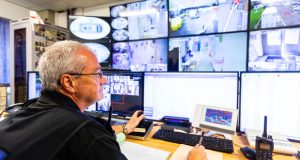 THE GLOBAL MANUFACTURER’S VIEW
THE GLOBAL MANUFACTURER’S VIEW
MATT WINN,
SR. DIRECTOR, PUBLIC RELATIONS AND CORPORATE COMMUNICATIONS, HID GLOBAL
The past two years have indeed shaped many things and accelerated new opportunities in the security industry. There are three main topics and corresponding technologies that will impact facilities managers as we begin to emerge from the pandemic.
Physical Security in a Hybrid Work Model: During quarantine, remote working reached all-time highs. Recent reports indicate that roughly half the workforce in the UK, Europe and United States was remote during lockdown. The pandemic also laid bare the inflexibilities and vulnerabilities within existing security architecture.
The security and identity industry must evolve to meet emerging challenges and expectations of a workplace that is everywhere now that the future of work is here. This means upgrading infrastructure to support solutions, both in the cloud and on-premise, that are not only highly secure, but frictionless and future-ready. Hybrid work models also require FMs to reassess how users access doors, networks and more. New standards such as multi-factor authentication (MFA) and passwordless authentication improve security and cyber-hardening of digital systems to support a remote workforce.
Contactless Technologies: Throughout 2022 and beyond, a combination of biometrics and cloud-based authentication solutions is poised to fuel more secure and faster interactions with technologies used to access places and experiences, as well as muti-site facilities such as universities and hospitals. Already widely used in banking and financial services, fingerprint biometrics is expanding into broader applications.
For these systems that create, delegate, deliver and present trusted identity data for access applications, biometrics will confirm that users are who they say they are, and they are doing what was intended. More importantly, biometric authentication eliminates risks associated with unlawful acquisition of traditional keys, passwords, tokens or other physical access devices.
Data Science: As a final point, today’s digital transformation and the modern mechanisms of physical and logical security are producing a steady and growing flow of information. Increasingly, this data is being leveraged for analysis to make security operations more efficient and effective. Data creates context around human behaviours and patterns of activity, whether in a physical space or in a network. These insights help to highlight anomalies, empowering security professionals to more quickly identify or predict abnormal behaviours.
As artificial intelligence and machine-learning technologies are woven into the fabric of trusted identity solutions across the physical and digital security continuum, they will optimise the accuracy of threat detection and prediction. These technologies are already improving the performance and accuracy of biometric solutions and are detecting financial fraud and enabling predictive physical security. As organisations commit to react more quickly and precisely to mitigate threats and user needs, data science will officially occupy a central position in security.
 THE PERIMETER PROTECTION SOLUTIONS PROVIDER’S VIEW
THE PERIMETER PROTECTION SOLUTIONS PROVIDER’S VIEW
ALEXANDRA WELLER,
HERAS KEY ACCOUNT MANAGER
The next generation of perimeter intrusion detection systems (PIDSs) is already being rolled out to significantly increase the level of perimeter protection for sites ranging from ones of national or strategic importance through to warehousing hubs, data centres, food processing and distribution centres, healthcare facilities, and more.
The two leading PIDSs are GeoMic and GeoPoint. GeoMic (the so-called listening fence) uses a discreet microphonic sensor cable that listens for sounds – such as those generated from an intrusion attempt – around the entire perimeter. And the GeoPoint sensor system utilises multiple sensors that are distributed along the fence line to detect movement and vibration. This enables more-accurate visual verification of an intrusion when used in conjunction with video security management.
Both solutions are playing a pivotal role in speeding up the time in which onsite security teams (or designated staff) can verify and act upon an alarm when it is triggered.
In terms of maintenance and support, good suppliers will offer a multi-layered approach. The first layer will be the use of cloud-based portals that offer real-time insights into the status and performance of perimeter and entrance control systems. This includes all site entrance points, such as swing, sliding and bi-fold gates, as well as remote monitoring of user access and automatic alerts and notifications via smartphone, tablet or PC.
The speed at which the cyber and physical worlds are converging makes our industry a very exciting space right now. Speaking as Europe’s leading end-to-end supplier of permanent and mobile perimeter protection solutions, we believe that the demand to secure sites physically (with fencing, gates, turnstiles, barriers, etc.) is only set to continue.
But that hasn’t stopped us from embracing new technology by building ground-breaking alliances with both technology partners and high-level security contractors to develop a cohesive approach in areas such as LiDAR (light detection and ranging).
LiDAR systems use light-sensing technology that emits pulses of eye-safe lasers and records the time it takes the beam to return to the sensor after reflection from a target. This information can then be used to generate a 3D point cloud image that visualises valuable information on spatial location to help identify, classify and track moving objects via the intelligent software. The system allows FMs and site owners to configure rules to trigger point cloud recordings, network actions and/or automatically control PTZ camera movement to follow selected individuals.
The powerful data collected by the system provides the user with a situational overview in real time and site wide by tracking hundreds of points of interest simultaneously. This information can help in key decision-making assessments regarding threats, the employment of assets and even lockdown protocols.
What the FM industry will find really interesting is that LiDAR solves any GDPR issues, as the sensor does not require the capture or storage of any personally identifiable information. As a result, the solution protects individual privacy and poses zero PII risk.




